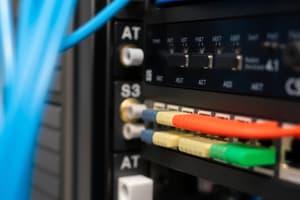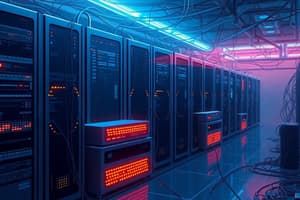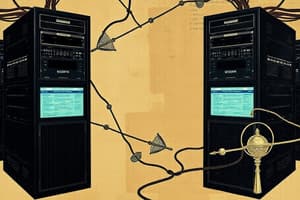Podcast
Questions and Answers
Which of the following is NOT one of the three broad categories of network components?
Which of the following is NOT one of the three broad categories of network components?
- Devices
- Media
- Protocols (correct)
- Services
End devices are where messages originate from or are received.
End devices are where messages originate from or are received.
True (A)
What role does an intermediary device play in a network?
What role does an intermediary device play in a network?
Interconnects end devices and manages data flow.
A type of wireless network media uses ______ transmission technology.
A type of wireless network media uses ______ transmission technology.
Match the following network devices with their functions:
Match the following network devices with their functions:
What type of media is commonly used for high-speed data transfer in networking?
What type of media is commonly used for high-speed data transfer in networking?
A network diagram represents only the end devices in a network.
A network diagram represents only the end devices in a network.
Name one type of intermediary device used in networking.
Name one type of intermediary device used in networking.
Which of the following devices can be used under BYOD policies?
Which of the following devices can be used under BYOD policies?
Collaboration is a low priority for businesses.
Collaboration is a low priority for businesses.
What is cloud computing primarily used for?
What is cloud computing primarily used for?
Applications that can be accessed using the Cloud include ______ and photo editing.
Applications that can be accessed using the Cloud include ______ and photo editing.
What type of cloud is intended for a specific organization such as the government?
What type of cloud is intended for a specific organization such as the government?
Match the following types of clouds with their descriptions:
Match the following types of clouds with their descriptions:
Which of the following is a characteristic of a Local Area Network (LAN)?
Which of the following is a characteristic of a Local Area Network (LAN)?
Cloud computing is only available to large enterprises.
Cloud computing is only available to large enterprises.
Wide Area Networks (WANs) provide high-speed links between LANs.
Wide Area Networks (WANs) provide high-speed links between LANs.
What is an example of a collaboration tool mentioned?
What is an example of a collaboration tool mentioned?
Name one type of network other than LAN or WAN.
Name one type of network other than LAN or WAN.
The Internet is a worldwide collection of interconnected _______ and _______.
The Internet is a worldwide collection of interconnected _______ and _______.
What is usually true about the administration of Wide Area Networks (WANs)?
What is usually true about the administration of Wide Area Networks (WANs)?
The Internet is owned by a single organization.
The Internet is owned by a single organization.
What is a characteristic of converged networks?
What is a characteristic of converged networks?
Match the following types of networks with their definitions:
Match the following types of networks with their definitions:
Fault tolerance in network architecture ensures that a failure affects all devices.
Fault tolerance in network architecture ensures that a failure affects all devices.
What does QoS stand for in network architecture?
What does QoS stand for in network architecture?
The groups developed to help maintain structure on the Internet include _______, ________, and _______.
The groups developed to help maintain structure on the Internet include _______, ________, and _______.
Converged networks deliver _____, voice, and video over the same infrastructure.
Converged networks deliver _____, voice, and video over the same infrastructure.
Match the following network characteristics with their definitions:
Match the following network characteristics with their definitions:
Which of the following best describes traditional separate networks?
Which of the following best describes traditional separate networks?
Converged networks can only operate if they have dedicated cabling for video services.
Converged networks can only operate if they have dedicated cabling for video services.
Identify one benefit of a fault tolerant network.
Identify one benefit of a fault tolerant network.
Which of the following is NOT considered an external threat?
Which of the following is NOT considered an external threat?
Network security involves only software solutions.
Network security involves only software solutions.
What are two examples of internal threats to network security?
What are two examples of internal threats to network security?
The implementation of security should involve __________ to address various threats.
The implementation of security should involve __________ to address various threats.
Match the following types of attacks to their definitions:
Match the following types of attacks to their definitions:
What is a primary reason internal users cause the most security breaches?
What is a primary reason internal users cause the most security breaches?
What two types of software should be installed on end devices for network security?
What two types of software should be installed on end devices for network security?
Data interception and theft are categorized as internal threats.
Data interception and theft are categorized as internal threats.
What is the primary characteristic of a Local Area Network (LAN)?
What is the primary characteristic of a Local Area Network (LAN)?
Wide Area Networks (WANs) provide high-speed connections between Local Area Networks (LANs).
Wide Area Networks (WANs) provide high-speed connections between Local Area Networks (LANs).
Name one type of network other than LAN or WAN.
Name one type of network other than LAN or WAN.
The Internet interconnects multiple ______ and ______.
The Internet interconnects multiple ______ and ______.
Match the following types of networks with their characteristics:
Match the following types of networks with their characteristics:
Which organization is responsible for maintaining Internet structure?
Which organization is responsible for maintaining Internet structure?
WANs are usually administered by a single organization.
WANs are usually administered by a single organization.
What type of connections does the Internet primarily use to facilitate its networks?
What type of connections does the Internet primarily use to facilitate its networks?
Which of the following is NOT one of the three goals of network security?
Which of the following is NOT one of the three goals of network security?
Availability in network security refers to the assurance that data will remain confidential.
Availability in network security refers to the assurance that data will remain confidential.
What does BYOD stand for?
What does BYOD stand for?
The three main goals of network security are __________, __________, and __________.
The three main goals of network security are __________, __________, and __________.
Match the following types of network security with their descriptions:
Match the following types of network security with their descriptions:
Which trend involves using personal devices in the workplace?
Which trend involves using personal devices in the workplace?
Information security focuses on physical security measures of network devices.
Information security focuses on physical security measures of network devices.
Name one new networking trend that impacts consumers.
Name one new networking trend that impacts consumers.
What is the purpose of an Intrusion Prevention System (IPS)?
What is the purpose of an Intrusion Prevention System (IPS)?
Access control lists (ACLs) are used to enhance network security by filtering access.
Access control lists (ACLs) are used to enhance network security by filtering access.
Name one benefit of using a Virtual Private Network (VPN).
Name one benefit of using a Virtual Private Network (VPN).
Networks need to be __________ to support increased demand and additional devices.
Networks need to be __________ to support increased demand and additional devices.
Match the following network requirements with their descriptions:
Match the following network requirements with their descriptions:
What is the primary purpose of an intranet?
What is the primary purpose of an intranet?
Which of the following is NOT a requirement for networks mentioned?
Which of the following is NOT a requirement for networks mentioned?
What is one characteristic that is necessary for networks to support communication?
What is one characteristic that is necessary for networks to support communication?
An extranet is intended for use solely within an organization.
An extranet is intended for use solely within an organization.
Name one type of broadband connection commonly used by home users.
Name one type of broadband connection commonly used by home users.
Larger networks typically require fewer security measures than smaller networks.
Larger networks typically require fewer security measures than smaller networks.
An organization might use an extranet to provide secure access for ______ who work for a different organization.
An organization might use an extranet to provide secure access for ______ who work for a different organization.
Match the following Internet connection types with their descriptions:
Match the following Internet connection types with their descriptions:
Which of the following is NOT a business-class interconnection type?
Which of the following is NOT a business-class interconnection type?
Cable connections provide lower bandwidth compared to DSL.
Cable connections provide lower bandwidth compared to DSL.
What type of connection is commonly used for video conferencing in organizations?
What type of connection is commonly used for video conferencing in organizations?
Which of the following is an example of an external security threat?
Which of the following is an example of an external security threat?
Internal users are the primary cause of network security breaches.
Internal users are the primary cause of network security breaches.
What is one security solution that should be implemented in a home or small office network?
What is one security solution that should be implemented in a home or small office network?
____ are malicious programs that can replicate themselves and spread to other systems.
____ are malicious programs that can replicate themselves and spread to other systems.
Match the following security threats with their descriptions:
Match the following security threats with their descriptions:
What should be implemented on end devices for better network security?
What should be implemented on end devices for better network security?
All security implementations are effective if only one layer is used.
All security implementations are effective if only one layer is used.
What does BYOD stand for in terms of network security?
What does BYOD stand for in terms of network security?
Flashcards are hidden until you start studying
Study Notes
Network Components Overview
- Networks can range from simple single cable connections between two computers to complex global interconnections.
- Network infrastructure consists of three main categories: devices, media, and services.
End Devices
- End devices are the starting and ending points for messages.
- Data originates from an end device, travels through the network, and arrives at another end device.
Intermediary Network Devices
- Intermediary devices connect end devices within a network.
- Examples include switches, wireless access points, routers, and firewalls.
- Intermediary devices manage data flow by regenerating and retransmitting signals, maintaining network pathway information, and notifying other devices of errors or failures.
Network Media
- Network media carries communication across a network.
- Common media types include:
- Metallic wires within cables, such as copper
- Glass, such as fiber optic cables
- Wireless transmission
Network Representations
- Network diagrams, often called topology diagrams, use symbols to represent devices within a network.
- Important terms to understand:
- Network Interface Card (NIC)
- Physical Port
- Interface
Topology Diagrams
- Physical topology diagrams show the physical location of devices.
- Logical topology diagrams represent ports and network addressing schemes.
LANs, WANs, and the Internet
- Two common network types:
- Local Area Network (LAN) - spans a small geographic area, often within a single building or organization.
- Wide Area Network (WAN) - spans a large geographic area, often connecting multiple LANs across cities, states, or countries.
Other Network Types
- Metropolitan Area Network (MAN) - spans a city or metropolitan area.
- Wireless LAN (WLAN) - uses wireless media to connect devices.
- Storage Area Network (SAN) - specialized network for high-speed data storage and access.
LAN Characteristics
- Small geographic area, such as a home, school, or office building.
- Administered by a single individual or organization.
- High-speed bandwidth for end devices.
WAN Characteristics
- Connects LANs over long distances.
- Administered by multiple service providers.
- Typically provides slower speeds compared to LANs.
The Internet
- Global collection of interconnected LANs and WANs.
- LANs are connected using WANs, which are then connected using various physical media.
- Structure and governance:
- Internet Engineering Task Force (IETF)
- Internet Corporation for Assigned Names and Numbers (ICANN)
- Internet Architecture Board (IAB)
Converged Networks
- Converged networks carry multiple services (data, voice, video) over a single link.
- This eliminates the need for dedicated separate networks with different technologies and standards.
Network Architecture Characteristics
- Fault Tolerance - reduces the impact of failures by minimizing affected devices.
- Scalability - ability to expand the network to accommodate additional devices and users.
- Quality of Service (QoS) - prioritizes different types of traffic to ensure specific applications perform well.
- Security - protects against unauthorized access, data breaches, and other threats.
Network Trends
- Bring Your Own Device (BYOD) - allows users to connect personal devices to the network.
- Online Collaboration - enables individuals to work together on projects over the network.
- Cloud Computing - provides access to resources (storage, applications) over the Internet.
- Public Clouds - services available to the general public.
- Private Clouds - services and applications for a specific organization or entity.
Network Security
- Network security is crucial for protecting data and resources.
- Security solutions must address both internal and external threats.
- Common security threats:
- Viruses, worms, Trojan horses
- Spyware and adware
- Zero-day attacks
- Hacker attacks
- Denial of Service attacks
- Data interception and theft
- Identity theft
Security Solution Components
- Antivirus and antispyware software on end devices.
- Firewall filtering to block unauthorized access.
- Intrusion Detection and Prevention Systems (IDS/IPS) to monitor and prevent attacks.
- Secure network configurations and protocols.
- User education and training on security best practices.
Local Area Network (LAN)
- Spans a small geographic area
- Usually administered by a single organization or individual.
- Provides high-speed bandwidth to end and intermediary devices within the network.
Wide Area Network (WAN)
- Interconnects LANs over wide geographical areas
- Usually administered by multiple service providers.
- Typically provide slower speed links between LANs.
The Internet
- Worldwide collection of interconnected LANs and WANs.
- LANs are connected to each other using WANs.
- WANs are then connected to each other using copper wires, fiber optic cables, and wireless transmissions.
- Not owned by any individual or group.
Intranets and Extranets
- Intranets are private collections of LANs and WANs internal to an organization, accessible only to members or authorized individuals.
- Extranets provide secure access to an organization's network for external individuals who need access to data.
Internet Access Technologies
- Popular services for home users and small offices include broadband cable, broadband digital subscriber line (DSL), wireless WANs, and mobile services.
- Organizations need faster connections to support IP phones, video conferencing, and data center storage.
- Business-class interconnections are usually provided by service providers (SP) and may include: business DSL, leased lines, and Metro Ethernet.
Cable
- High bandwidth, always-on internet connection offered by cable television service providers.
DSL
- High bandwidth, always-on Internet connection that runs over a telephone line.
Network Security
- Two main types:
- Network infrastructure security: Physical security of network devices, preventing unauthorized access to management software.
- Information security: Protection of information or data transmitted over the network.
Three Goals of Network Security
- Confidentiality: Only intended recipients can read the data.
- Integrity: Assurance that the data has not been altered during transmission.
- Availability: Assurance of timely and reliable access to data for authorized users.
Network Trends
- Bring Your Own Device (BYOD)
- Online collaboration
- Video communications
- Cloud computing
Network Security Threats
- External Threats:
- Viruses, worms, and Trojan horses
- Spyware and adware
- Zero-day attacks
- Hacker attacks
- Denial of Service attacks
- Data interception and theft
- Identify Theft
- Internal Threats:
- Intentional or unintentional security breaches by internal users.
- BYOD strategies increase vulnerability of corporate data.
Network Security Solutions
- Antivirus and antispyware software should be installed on end devices.
- Firewall filtering used to block unauthorized access to the network.
- Dedicated firewall system: Provides more advanced firewall capabilities.
- Access control lists (ACL): Used to further filter access and traffic forwarding.
- Intrusion prevention systems (IPS): Used to identify fast-spreading threats such as zero-day attacks.
- Virtual private networks (VPN): Used to provide secure access for remote workers.
Exploring the Network
- Networks and the Internet have a dramatic impact on our lives.
- A network can consist of two devices or can be as large as the Internet, consisting of millions of devices.
- The network infrastructure is the platform that supports the network.
- Networks must be:
- Fault-tolerant
- Scalable
- Support Quality of Service (QoS)
- Secure
Studying That Suits You
Use AI to generate personalized quizzes and flashcards to suit your learning preferences.




